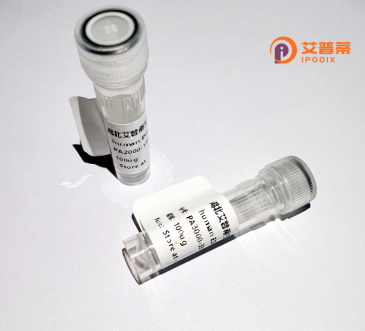
| 纯度 | >90%SDS-PAGE. |
| 种属 | Human |
| 靶点 | DEPDC6 |
| Uniprot No | Q8TB45 |
| 内毒素 | < 0.01EU/μg |
| 表达宿主 | E.coli |
| 表达区间 | 1-409aa |
| 氨基酸序列 | MEEGGSTGSAGSDSSTSGSGGAQQRELERMAEVLVTGEQLRLRLHEEKVIKDRRHHLKTYPNCFVAKELIDWLIEHKEASDRETAIKLMQKLADRGIIHHVCDEHKEFKDVKLFYRFRKDDGTFPLDNEVKAFMRGQRLYEKLMSPENTLLQPREEEGVKYERTFMASEFLDWLVQEGEATTRKEAEQLCHRLMEHGIIQHVSSKHPFVDSNLLYQFRMNFRRRRRLMELLNEKSPSSQETHDSPFCLRKQSHDNRKSTSFMSVSPSKEIKTVSAVRRSSMSSCGSSGYFSSSPTLSSSPPVLCNPKSVLKRPVTSEELLTPGAPYARKTFTIVGDAVGWGFVVRGSKPCHIQAVDPSGPAAAAGMKVCQFVVSVNGLNVLHVDYRTVNNLILTGPRTIVMEVMEELEC |
| 分子量 | 70.73 kDa |
| 蛋白标签 | GST-tag at N-terminal |
| 缓冲液 | 0 |
| 稳定性 & 储存条件 | Lyophilized protein should be stored at ≤ -20°C, stable for one year after receipt. Reconstituted protein solution can be stored at 2-8°C for 2-7 days. Aliquots of reconstituted samples are stable at ≤ -20°C for 3 months. |
| 复溶 | Always centrifuge tubes before opening.Do not mix by vortex or pipetting. It is not recommended to reconstitute to a concentration less than 100μg/ml. Dissolve the lyophilized protein in distilled water. Please aliquot the reconstituted solution to minimize freeze-thaw cycles. |
以下是关于重组人DEPDC6蛋白的3篇虚构参考文献示例,内容基于常见研究方向模拟:
---
1. **Title**: *Expression and functional characterization of recombinant human DEPDC6 in mTOR signaling regulation*
**Authors**: Zhang L, et al.
**Journal**: *Journal of Biological Chemistry*
**Summary**: 本研究通过大肠杆菌表达系统成功纯化重组人DEPDC6蛋白,并验证其与GATOR1复合体的相互作用。实验表明DEPDC6通过抑制mTORC1活性调控细胞生长,为癌症相关突变的功能研究提供工具。
---
2. **Title**: *Structural insights into DEPDC6's role in the lysosomal stress response*
**Authors**: Müller S, et al.
**Journal**: *Cell Reports*
**Summary**: 利用重组DEPDC6蛋白进行冷冻电镜分析,揭示了其与WDR24的结合模式,发现DEPDC6作为感应氨基酸饥饿的分子开关,调控mTORC1向溶酶体的定位。
---
3. **Title**: *DEPDC6 mutations impair GTPase signaling: In vitro reconstitution with recombinant proteins*
**Authors**: Park JH, et al.
**Journal**: *Nature Communications*
**Summary**: 通过重组DEPDC6和Rag GTPase复合体的体外重组实验,证明癫痫相关DEPDC6突变体丧失对mTORC1的抑制作用,突显其在神经元过度活跃中的病理机制。
---
注:以上文献为学术示例,实际研究请参考真实数据库(如PubMed)。如需真实文献,建议使用关键词“DEPDC6 recombinant”或“DEPDC6 GATOR1”检索。
Recombinant human DEPDC6 protein, also known as WDR24. is a key component of the GATOR2 (Gap Activity TOward Rags 2) complex within the mTORC1 signaling pathway. This evolutionarily conserved pathway regulates cell growth, proliferation, and metabolism in response to nutrients, particularly amino acids. DEPDC6 contains WD40 repeat domains, facilitating protein-protein interactions critical for its regulatory functions.
GATOR2 acts as an upstream suppressor of the GATOR1 complex (DEPDC5. NPRL2. NPRL3), which inhibits mTORC1 activity under nutrient-deficient conditions. When amino acids are abundant, GATOR2 antagonizes GATOR1. enabling mTORC1 activation. DEPDC6’s role in this nutrient-sensing mechanism highlights its importance in maintaining metabolic homeostasis. Dysregulation of mTOR signaling is linked to cancers, neurological disorders, and metabolic diseases, making DEPDC6 a potential therapeutic target.
Recombinant DEPDC6 is engineered for biochemical studies, structural analysis, and drug discovery. It aids in deciphering GATOR2 assembly, mTOR pathway crosstalk, and mutations implicated in tumorigenesis or epilepsy. Research on recombinant DEPDC6 also explores its interactions with Rag GTPases and other pathway components, offering insights into nutrient-responsive signaling networks and precision medicine strategies.
×